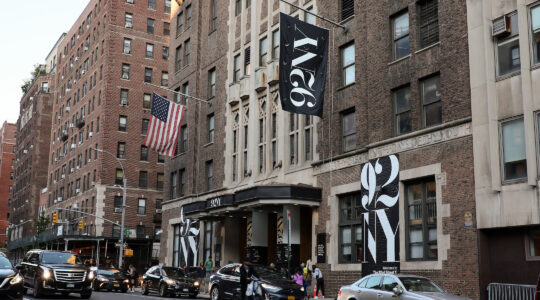When John Ruskay met with a major donor to UJA-Federation of New York Monday in the man’s Midtown office, multiple screens on his desk flashed with stock prices and minute-by-minute financial updates. Their first order of business was to talk about the volatility currently wreaking havoc in the hedge fund, credit and mortgage markets.
“By his account he has tens of millions of dollars in one of the largest Wall Street firms,” said Ruskay, chief executive officer of UJA-Federation, which is the largest Jewish federation in North America. “While the value of his holdings in this firm has declined about 20 percent recently, he said it’s still up compared to last year. That doesn’t mean the loss doesn’t hurt, but he was wise to contextualize it.
“I don’t think it will hurt his giving,” Ruskay said. He sure hopes not.
Ruskay and most other professionals running nonprofits are apprehensively watching the financial markets’ gyrations, hoping that the recent downturn doesn’t continue or cut deeply into the donations that flood in toward the end of each year.
What’s happening right now may be worrisome, they say, but what happens in the fourth quarter will have a tangible effect.
Roughly half of all donations to nonprofits reach them in December, said Stacy Palmer, editor of the Chronicle of Philanthropy. At this point, there is “more concern than any actual impact,” she said Tuesday, when the Dow Jones Industrial Average fell another 207 points.
For UJA-Federation, for example, “cash is huge in December,” according to Paul Kane, senior vice president for financial resource development. Some $40 million in cash comes in during December alone.December is when Wall Street employees often get their multimillion dollar bonuses — and the New York federation’s annual fundraising dinner is held that month, Kane said.
While no one has seen current donations thin because of the last several weeks of financial market instability, they all expressed concern about it continuing.
But this is the slowest month of the year for philanthropy, said Mark Charendoff, president of the Jewish Funders Network (jfunders.org), which provides support and training for family and private foundations as well as foundation professionals.
“If this turns out to be a passing blip on the economic calendar, then this is the best possible time for it to come because it won’t impact decisions people are making,” said Charendoff. “The question is whether this continues into the fall. If it does, then you get into the absolute busiest time of the year when the vast majority of philanthropic decisions are made. Then we could see a real impact.”
For nonprofit recipients, the concern is over what they will receive. For donors and foundations, it’s about how much they may have to give if investments fail to generate as much in interest and dividends as they have been.
Most foundations invest for the long term, “so this kind of short-term crisis does not affect grant-making,” said Jeffrey Solomon, president of the Andrea and Charles Bronfman Philanthropies (acbp.net). “To date it hasn’t impacted our work.”
Support the New York Jewish Week
Our nonprofit newsroom depends on readers like you. Make a donation now to support independent Jewish journalism in New York.
Together with sister foundations in Canada and Israel, Bronfman philanthropies have assets totaling $130 million.
At the Jewish Communal Fund (jewishcommunalfund.org), “we’re not seeing any impact just yet” from the recent economic instability, said Ellen Israelson, director of fund development. And, she said, she’s not expecting to.
The JCF houses $958 million in assets from 2,400 donors, who direct their donations to recipients of their choice and in the year that ended on June 30, made $227 million in grants. The organization’s assets under management have risen by almost 50 percent over the past two years, she said, from $685 million in 2005.
“The last several years have been so terrific that we expect whatever impact this has will not substantially change our position. The financial services sector was a very significant piece of the growth, but not all of it. Grant-making is still very active,” Israelson said. When the economy shook after Enron’s collapse in 2002, JCF saw donors pull back on donations to their portfolios, but continue giving money from them. “Donors contribute to their funds when the market is strong so that they will have charitable assets available for grant making during leaner times,” Israelson said. “Our donors were able to keep their charitable commitments during the downturn in the stock market, and we expect that trend to continue.”
Natan (natan.org) is focused on young philanthropists, bringing together donors ages 30-45 — many of them hedge fund and other finance managers — for peer networking and grant making.
Felicia Herman, its executive director, expects to bring in at least what the group did last year, $1.2 million. “I know that some people are doing better and some people are doing worse right now. People are just really busy trying to sort it all out,” she said. “It’s only August.”
To be sure, some smaller recipient groups are already feeling more vulnerable.
Chai Lifeline (chailifeline.org) is a Manhattan-based organization serving seriously ill Jewish children and their families with a range of support services, and has an $18.5 million annual budget.
Small donations are central to Chai Lifeline’s stability and account for $10 million this year from gifts of $1,000 and under, said founder and Executive Vice President Rabbi Simcha Scholar.
“We are a firm believer in the small money, and that is really not going to be affected by the market. People are going to give their $36 and $50 anyway,” said Rabbi Scholar. “The smaller donors are the continuity, but you can’t expand” without big donations, he said.
Major gifts, at risk because of economic instability, are “the reasons you’re able to build new buildings and create new projects,” like the respite center Chai Lifeline is planning in Manhattan for families of seriously ill children.
“There’s no question that this market thing is going to hurt some of the major donors and put some big projects on hold for organizations like ours,” Rabbi Scholar said. “We have to tread very, very carefully.“But we’ve survived real estate and other stock crashes before. I am a person of tremendous faith. God watches over this place and we’ll somehow weather the storm.”
Support the New York Jewish Week
Our nonprofit newsroom depends on readers like you. Make a donation now to support independent Jewish journalism in New York.
Even beyond the fourth quarter, Wall Street has become a driver of nonprofit revenue as bonuses have boomed along with the stock market. Its impact on New York City’s economy overall is hard to overstate.
It is also responsible for the uptick in income for many Jewish nonprofits.
The Wall Street division is the single largest source of revenue for UJA-Federation, says Kane, responsible for $40 million of the most recent $151 million annual campaign. The real estate division is the second most lucrative of the organization’s trade groups, bringing in $18.4 million to the annual campaign.Jewish federations all over the country are recognizing the potential of the financial services industry, and “a number of large federations have opened up divisions focusing on it in the last couple of years,” says Vicki Agron, senior vice president for development at United Jewish Communities. UJC is the umbrella organization for 155 Jewish federations in North America, which raised a total of $890 million in 2006.
“Real estate and financial services, those are the big ones we look to as market indicators,” said Agron. “They are the bellwether.”




